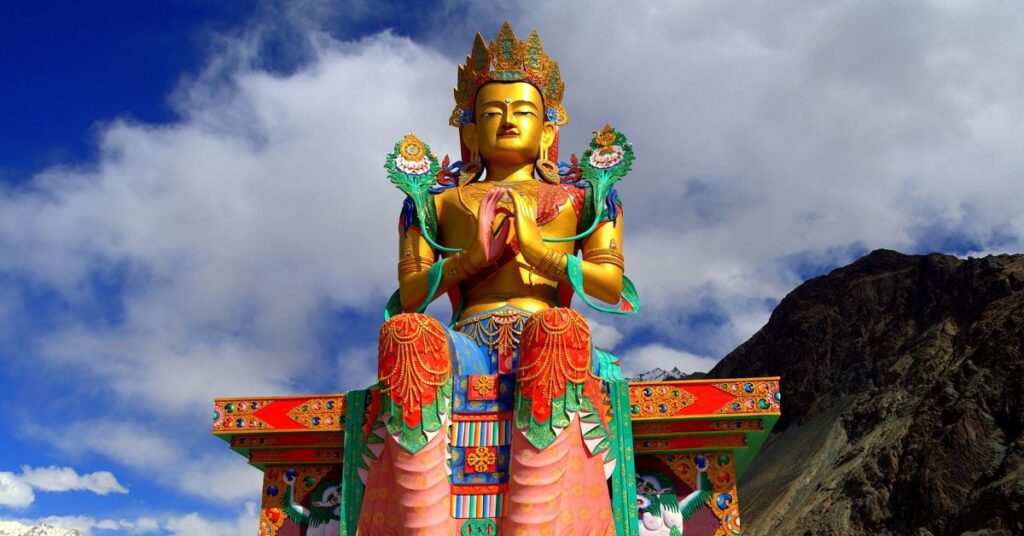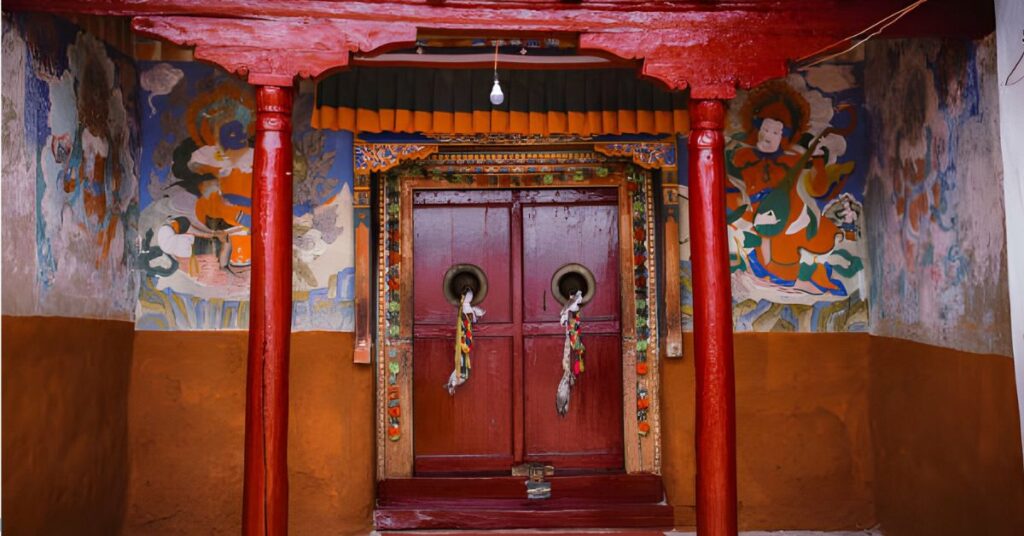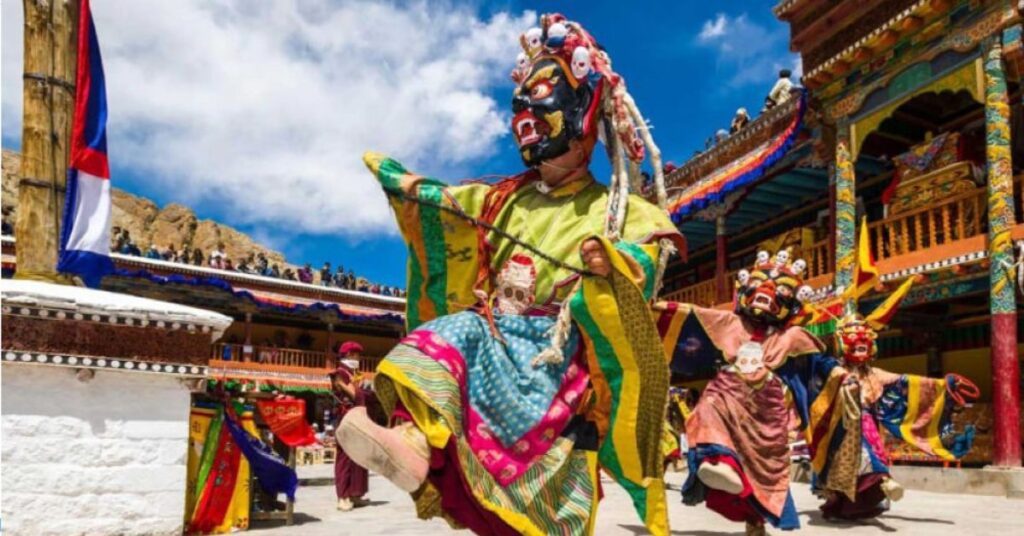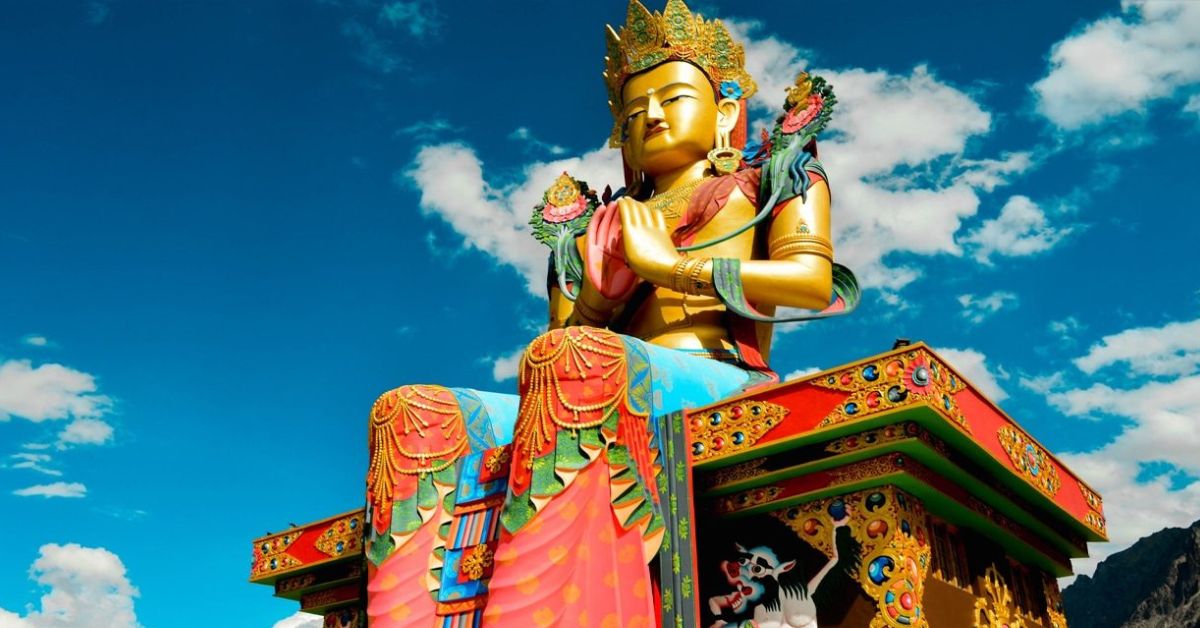Diskit Monastery is a magical place in the Nubra Valley. It’s really old and very important to the people of Ladakh. Sitting on a hill, you can see the whole valley and it’s just breathtaking. The monastery is full of beautiful pictures and statues, and there’s even a giant Buddha statue that watches over everything.
It’s like stepping back in time when you visit. You can feel the peace and learn about the special things the people believe in. It’s not just a pretty place, it’s a place where you can really understand the heart of Ladakh.
How to reach:
By Air:
The closest airport is in Leh, Ladakh. You can fly there from major Indian cities.
By Road:
Diskit Monastery is about 120 kilometers from Leh. You can hire a taxi or rent a car for the drive. The journey takes about 4-6 hours and passes through the scenic Nubra Valley. Be aware that you’ll need to cross the Khardung La Pass, one of the world’s highest motorable roads.
By Motorcycle or Bike:
For adventure seekers, renting a bike is a popular option. The ride offers stunning views but be prepared for challenging road conditions.
Important Note:
You’ll need a special permit called an Inner Line Permit (ILP) to visit Diskit Monastery as it’s in a restricted area. Foreigners need a Protected Area Permit (PAP). Get these permits in Leh before your trip.
Best time to visit:
Summer (June to September)
Summer is the perfect time to visit Diskit Monastery. Enjoy pleasant weather, beautiful landscapes, and the lively Diskit Festival.
Autumn (October to November)
Autumn offers cooler weather, fewer crowds, and stunning fall colors. Be prepared for cooler temperatures and check road conditions.
Winter (December to February)
Winter is very cold with lots of snow. Many roads and services are closed. Only experienced travelers should visit during this time.
Spring (March to May)
Spring brings warmer weather and blooming flowers, but some places might still be closed after winter.
Attractions:
The Maitreya Buddha Statue:

The Maitreya Buddha statue at Diskit Monastery is a giant, beautiful statue of a very important person in Buddhism. It’s really tall and looks out over the whole valley. You can see it from far away and it’s really impressive. The statue sits on top of a hill so you get a great view of the mountains and valleys around it. It’s a peaceful and magical place to be.
Ancient Prayer Halls:
The prayer halls at Diskit Monastery are like stepping into a magical world. They’re filled with beautiful pictures and statues that tell stories about Buddha and other important people. The walls and ceilings are covered in shiny colors and patterns that make you feel peaceful and calm. It’s like looking at a really old storybook that’s full of wisdom and beauty.

The Diskit Festival:

The Diskit Festival is a big, fun party with lots of singing, dancing, and special ceremonies. Monks wear colorful masks and do cool dances that tell old stories about good and bad. Everyone comes together to celebrate and have a good time. It’s a great way to learn about Ladakh’s culture and traditions.
Local Experiences:
- Join the local fun: Experience the vibrant Diskit Festival with its colorful dances and music.
- Discover local treasures: Shop for unique handmade items at local markets.
- Savor local flavors: Enjoy delicious Ladakhi food like momos and thukpa.
- Connect with the monks: Learn about their lives and beliefs.
- Explore local life: Visit nearby villages to see how people live.
- Ride a camel: Experience the desert-like landscape of Hunder.
- Discover other monasteries: Explore other religious sites in the region.
- Capture stunning views: Take amazing photos of the beautiful scenery.
- Learn about local traditions: Visit traditional Ladakhi homes and learn about their way of life.
- Find inner peace: Participate in meditation sessions.
- Try your hand at local crafts: Learn how to make traditional items.
- Explore the natural beauty: Visit hot springs and other natural wonders.
Travel tips:
- Acclimatize: Spend a few days in Leh to adjust to the high altitude.
- Get permits: Obtain necessary permits before your trip.
- Check road conditions: Be aware of potential road closures, especially in winter.
- Pack warm: Layer your clothing for changing temperatures.
- Plan for limited connectivity: Inform others of your whereabouts.
- Carry cash: ATMs might be scarce.
- Respect local culture: Dress modestly and follow local customs.
- Stay hydrated: Drink plenty of water to combat altitude.
- Consider a guided tour: Gain deeper understanding of the region.
- Check weather updates: Be prepared for changing weather.
- Protect the environment: Minimize your impact on the region.
- Be prepared for emergencies: Have emergency contact information ready.
Conclusion
Diskit Monastery stands as a majestic testament to Ladakh’s rich cultural and spiritual heritage. Perched atop a hill, it offers breathtaking panoramic views of the Nubra Valley. The monastery’s towering Maitreya Buddha statue is a symbol of peace and hope, while its intricate prayer halls and museum house centuries of history and religious art. Immerse yourself in the vibrant Diskit Festival, explore nearby villages, or simply bask in the serene atmosphere of this remarkable place. A visit to Diskit Monastery is more than just sightseeing; it’s a journey into the heart of Ladakh’s captivating world. Follow our travel guide website Xplro.com and thanks for visiting.
FAQs
1. What makes Diskit Monastery special?
- Diskit Monastery is renowned for its striking 32-meter (105-foot) statue of Maitreya Buddha, which dominates the Nubra Valley’s landscape. As one of the oldest and largest monasteries in the region, it holds great importance in Tibetan Buddhism and offers visitors a rich cultural and spiritual experience with its historic prayer halls and vibrant festivals.
2. How can I get the required permits to visit Diskit Monastery?
- To visit Diskit Monastery, you will need an Inner Line Permit (ILP) if you’re an Indian national or a Protected Area Permit (PAP) if you’re a foreign visitor. These permits can be acquired from the Deputy Commissioner’s office or through travel agencies in Leh. It’s best to arrange these permits ahead of your visit.
3. When is the ideal time to visit Diskit Monastery?
- The ideal time to visit Diskit Monastery is between June and September when the weather is generally pleasant and road conditions are favorable. Autumn (October to November) is also a good time with fewer tourists and clear weather. Winter (December to February) can be harsh due to snow and cold temperatures, while spring (March to May) offers milder weather and fewer crowds.
4. How long does the drive from Leh to Diskit Monastery take?
- Driving from Leh to Diskit Monastery typically takes around 4 to 6 hours, covering approximately 120 kilometers (75 miles). The route includes crossing the Khardung La Pass, one of the world’s highest motorable passes, so travel times may vary depending on weather and road conditions.
5. What are the accommodation options near Diskit Monastery?
- There are several accommodation options near Diskit Monastery, including guesthouses, homestays, and small hotels in Diskit village. These options provide basic amenities and a chance to experience local hospitality. It’s advisable to book your stay in advance, especially during peak tourist seasons.
6. Can I experience any local festivals at Diskit Monastery?
- Yes, the Diskit Festival is a major annual event at the monastery. It includes traditional Cham dances, musical performances, and various religious rituals. Attending this festival offers a wonderful opportunity to immerse yourself in Ladakhi culture and Buddhist traditions.
7. What should I wear when visiting Diskit Monastery?
- Visitors are encouraged to dress modestly and respectfully. Opt for attire that covers your shoulders and knees. It is also customary to remove your shoes before entering the prayer halls. Avoid clothing that is too casual or revealing.
8. Is hiring a local guide recommended for visiting Diskit Monastery?
- While not required, hiring a local guide can greatly enhance your visit. A guide can provide detailed information about the monastery’s history, cultural significance, and religious practices, as well as assist with navigating the area and enriching your overall experience.
9. Are there dining options available near Diskit Monastery?
- Yes, you’ll find a few local eateries and guesthouses in the vicinity of Diskit Monastery where you can sample traditional Ladakhi dishes such as momos (dumplings) and thukpa (noodle soup). Dining options might be limited, so it’s a good idea to check ahead and plan accordingly.
10. What essentials should I bring when visiting Diskit Monastery?
- When visiting Diskit Monastery, bring essentials like warm clothing, especially during colder months, sun protection (including sunglasses, a hat, and sunscreen), water, and snacks. A camera for capturing the stunning views and religious artifacts is also recommended, and a notebook for any personal reflections.
11. Are there any local customs I should follow?
- Yes, be mindful of local customs and traditions. Always follow the guidelines provided by the monastery staff, remove your shoes before entering the prayer halls, and avoid touching or disturbing religious artifacts. It’s also courteous to ask for permission before taking photographs of people or sacred objects.
12. What are the best ways to travel around the Nubra Valley?
- In the Nubra Valley, transportation options include hiring a private taxi, joining a tour group, or renting a vehicle. Shared cabs and local buses are also available but may have limited schedules. For an adventurous option, consider renting a motorcycle or bike. Be prepared for the unique driving conditions in high-altitude areas.




